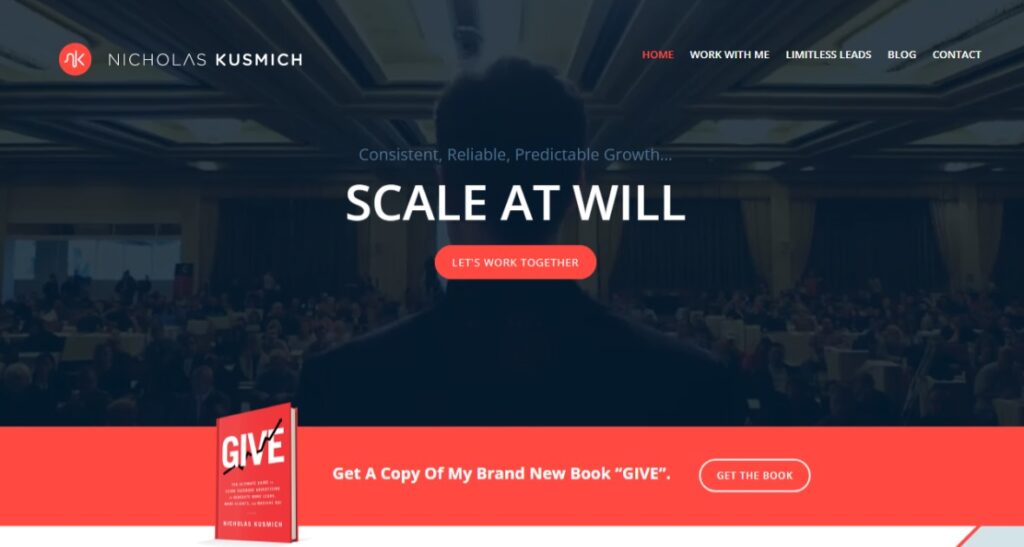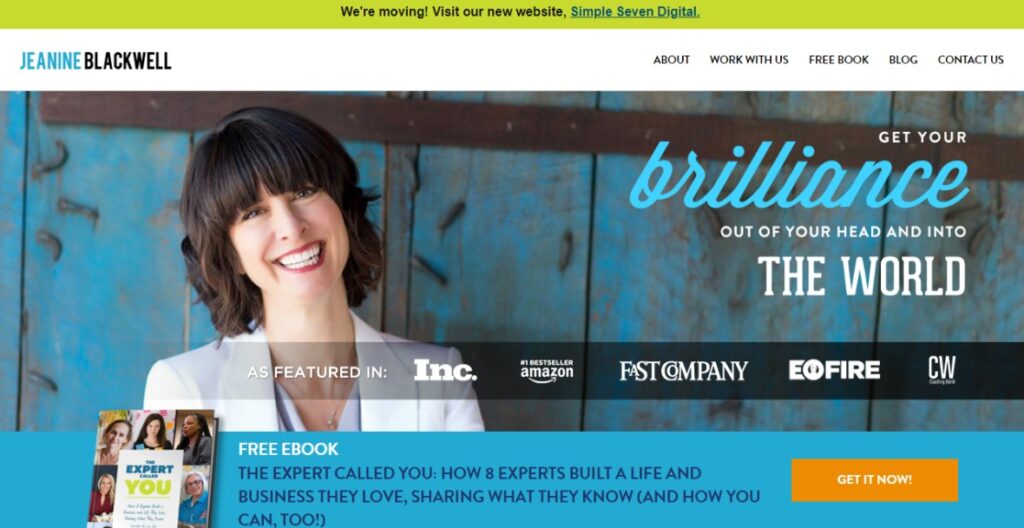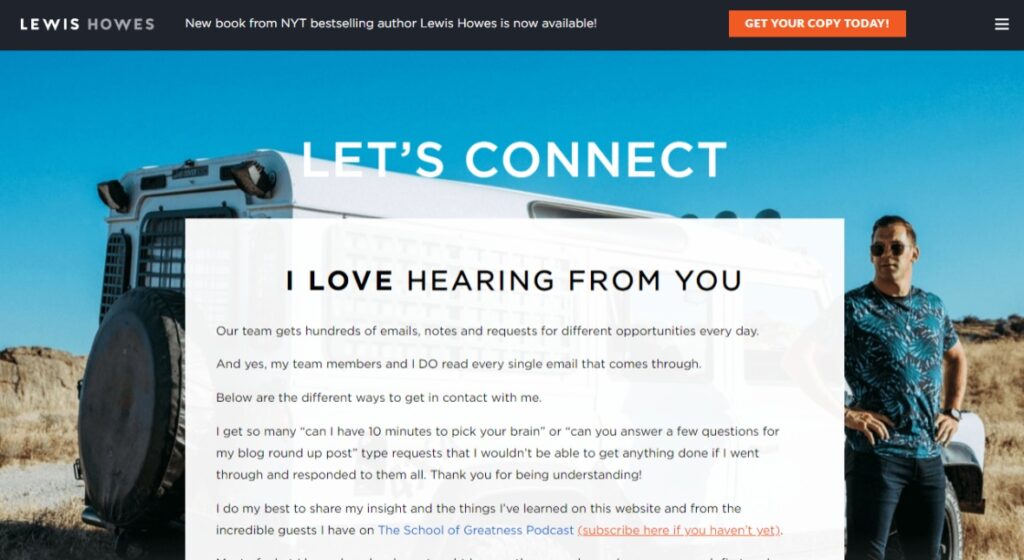Building a personal brand has never been easier or more important than it is today. Anyone with access to the internet and social media can build an audience, position themselves as an expert, and start attracting clients for their business.
A study by Upwork revealed that the freelance workforce is growing at a rate 3x faster than the overall workforce in the U.S. By 2027, freelancers are expected to make up the majority of the U.S. workforce.
The key to differentiating yourself from your competition? Learn how to build a personal brand and attract a community of like-minded, loyal followers. Here’s what you need to know.
Follow along or skip ahead:
- Why every entrepreneur should build a personal brand
- 6 benefits of building a personal brand
- How to build a compelling & profitable personal brand in 7 steps
- Start building your personal brand
Get the Free Personal Branding Worksheet
Download our fillable workbook to help develop your personal brand strategy and brand content tactics
Why every entrepreneur should build a personal brand
A personal brand communicates who you are – including your unique strengths, expertise, personal values, and motivations.
When you learn how to build a personal brand, you learn how to market your strengths in a way that’s appealing to your target audience, establishing a personal connection with potential customers, followers, and partners.
A personal brand can help you get ahead – whether you’re building a business, pitching and applying for opportunities, or looking to strengthen an existing brand.
Why? Because people are generally more interested in following other people than they are in following specific companies. That means building an audience for your personal brand can also help increase exposure for an existing company too.
Elon Musk, for example, has more followers than 3 of his companies (Tesla, SpaceX, and SolarCity) combined. The same is true of Richard Branson (Virgin), Arianna Huffington (Thrive Global), Gary Vaynerchuck (VaynerMedia), and countless other highly successful entrepreneurs. They all have strong personal brands that they leverage to increase exposure and attract more customers to their companies.
“Having a personal brand is important for an entrepreneur because now more than ever, it’s important for CEOs and founders of companies/brands to come out to the forefront and connect with their audiences. People connect with people.”
6 benefits of building a personal brand:
- Increase trust and authority: Having a personal brand helps to build trust with your audience and position you as an authority and thought leader in your industry.
- Get featured in media: The media is in constant search of experts that can share their insights with their audience. A personal brand makes it easier for you to pitch and be found by influential media outlets – including online publications, magazines, television, radio, podcasts, and more.
- Build your network: When you know how to build a personal brand that clearly articulates who you are, what you do, and how you help others, it makes it easier for other people and entrepreneurs to see value in connecting with you. You can leverage your personal brand to build your network – both online and offline – quickly and effectively.
- Attract more clients: Building a personal brand that positions you as the go-to expert in a specific industry or niche helps you attract more of your ideal clients – and when you’re positioned as an expert, it’s easier for people to refer clients to you too.
- Demand premium prices: Having a strong personal brand helps justify charging premium prices for your products and services. Without a brand, you become a commodity that competes on cost (and there will always be competitors that can beat your price) – a personal brand communicates your value to your audience, allowing you to demand more money for the same services.
- Create a lasting platform: Over time, your business will evolve. You may even start multiple businesses in different industries. Your personal brand stays with you as you move from one venture to the next, creating a cohesive story that your audience and any potential customers can recognize and connect with.
“With SO MUCH content and SO MANY small businesses popping up online, a brand that connects to a person’s face is much easier to trust faster. It takes less time and effort to build a relationship with a personal brand as compared to a business brand.”
How to build a compelling & profitable personal brand in 7 steps
After interviewing dozens of successful entrepreneurs and branding experts, we’ve outlined 7 specific steps to help you learn how to build a personal brand that’s both magnetic and monetizable – to attract your ideal clients and open up new opportunities for your business.
We also created a Personal Branding Workbook to help you develop your personal brand strategy as you read through these steps. Download it now.
Get the Free Personal Branding Worksheet
Download our fillable workbook to help develop your personal brand strategy and brand content tactics
There’s a common misconception that building a personal brand means crafting a persona. But the truth is, a persona is not a true reflection of who you are. The result? Any attempt to build a brand around a persona feels inauthentic and fails to connect with your target audience.
The first step to building a personal brand is to lay a foundation that you can confidently and authentically build upon. The key principle here is authenticity.
Personal branding is not about positioning yourself as something you’re not. It’s about purposefully and strategically showcasing your authentic self to your audience and your customers to better connect with them. Your personal brand should be a true reflection of your genuine skills, strengths, passions, values, and beliefs.
It’s not only easier to show up as yourself, it will also have a stronger impact and resonate better with your target audience.
“You want to find the special thing that is YOU and make your brand all about that. You can’t make it up, it has to be real (though it can and probably should be a little exaggerated).”
Know your assets
When you’re building a personal brand, start by taking stock of the strengths, skills and assets you already have. Try asking yourself these questions:
- Skills and credentials: What skills have I acquired throughout my life? What training, credentials, certifications, or awards have I received?
- Passions and interests: What topics and industries am I most interested in? What am I passionate about? What subjects make my eyes light up?
- Core values and beliefs: What are some of my most important core values? What do I believe in? What do I stand for? What do I stand against?
Write 3 lists for each of the bullet points and then identify any patterns and crossovers that you could use as the foundation of your personal brand.
Identify key elements of your personal brand
The next step is to start piecing together the key elements of your personal brand. These will help guide your decisions as you build your brand. Ask yourself:
- Your brand vision: What do I want to be known for? If I became the world’s go-to expert on XYZ topic, what would I want that to be?
- Your brand mission: Why do I want to build a personal brand? What is my purpose? Who do I want to influence? What do I want to accomplish?
- Your brand message: What is the key message I want to communicate? What message do I want to consistently reinforce in my content and my marketing? If I could only give one piece of advice to my audience, what would it be?
- Your brand personality: What are some of my personal characteristics and traits that I can weave into my brand? Do I want to be perceived as polished and professional, or perhaps more quirky and adventurous, for example?
“A great brand starts with understanding who you are, what you stand for, understanding your marketplace, and understanding your positioning. What is the perception that you need to create in order to appeal to the target audience that you’re trying to appeal to?”
– Re Perez
Get the Free Personal Branding Worksheet
Download our fillable workbook to help develop your personal brand strategy and brand content tactics
One of the biggest mistakes you can make as you build a personal brand is to try to appeal to everyone. In reality, not everyone is your ideal client.
It might seem counterintuitive, but if you try to be liked by everyone, you’ll appeal to no one. The truth is, you don’t need to reach everyone to build a successful business. You just need to reach your perfect clients.
That means identifying a specific target audience – and building a personal brand that speaks to them specifically.
“The foundation of a strong personal brand is how well you understand your audience and the problems they face. Then you can define why you care and how you solve those problems, which is what you’ll be remembered for.”
Download the audience research workbook!
Create an ideal customer profile
The more you understand about your perfect client, including their desires, needs and challenges, the more prepared you’ll be to create the products and services they truly want and need.
Here are some questions to help you create your perfect client profile – also known as a customer avatar:
- Demographics: What is your ideal customer’s age, location, gender, education, relationship status, income, profession, and more?
- Desires and aspirations: What is their desired future? What are their dreams, goals, and aspirations?
- Pain points and challenges: What are they currently struggling with? What is preventing them from achieving their goals?
To learn more about how to create your perfect client profile, check out our guide to How To Define Your Target Audience (+Templates & Workbooks).
“To have a strong personal brand, you have to stand for something, believe in a certain way of doing things, and proudly communicate those beliefs from your platform. Brands who don’t achieve this get lukewarm audience response and wonder why their audiences aren’t called to action by their efforts.”
A key part of learning how to build a personal brand is understanding how to create an irresistible offer that will help your audience solve a specific problem or achieve a specific result.
A lot of entrepreneurs make the mistake of creating a generic product or service that they think their audience wants, only to discover that no one wants it – and is much less willing to pay for it.
This is why identifying your perfect client before you create a product or service is so important. When you know exactly who you want to help, you can create an offer that is the perfect solution for the challenges they’re facing.
How to create an offer your clients will love
The first step to crafting an irresistible offer is to position yourself as a specialist – rather than a generalist. A generic offer with a vague promise is definitely not irresistible.
Instead, you want to promise your clients a very specific outcome and design a specialized offer to help them achieve that outcome.
Next, find the overlap between what you love, what you do best and what your ideal clients want most. Then create an offer that sits at the intersection of those criteria. We call this the Irresistible Offer Formula.
Irresistible Offer Formula:
What you love to do + What you do best + What your audience wants most = Irresistible offer
Once you have your irresistible offer, you need to be able to articulate its value clearly and succinctly to your audience. Here are two questions you should be able to answer:
- What do you do? Your answer to this question is your value proposition. What is the value you provide to your clients in exchange for their investment?
- How do you do it? What is special about your process, product, or service? Try to give it a unique, catchy name. When you name your process or service, you immediately help it to stand out from any competing offers that promise the same results.
Example: Nicholas Kusmich, a Facebook Advertising Strategist, helps businesses rapidly scale revenue by getting more clients using Facebook Advertising. That’s what he does. To help him stand out from thousands of other Facebook Advertising experts who do the same thing, he developed a proprietary process and he gave it a unique name: “Contextual Congruence”.
Here’s a screenshot from his website homepage, describing what he does in a way that differentiates him from his competitors:

“People need to know who you are and what you do in the most simple way possible. Keep it simple. You should be able to brand yourself in 5 words or less.”
A personal website is an important component of building a personal brand. Unlike your social media profiles, you own and control your website. That means every visitor is a potential lead that you can convert into a customer.
First impressions are critical. When your target audience lands on your personal website, they should be able to immediately identify and understand who you are and how you can help them. They should feel like they’ve come to the right place.
If this doesn’t happen within a few seconds, most new visitors will simply bounce and leave your website.
As well as communicating your offer and your value, your website should also be optimized to convert casual visitors into paying customers. There are several key elements required to make this happen – and most of them belong right on your homepage.
Key elements of your website homepage:
- Your value proposition: Make sure your unique value proposition – who you help and how you help them – is pride of place on your homepage, ideally near the top.
- Professional photography: Get a photographer to take several professional-quality photographs of you. Use these photographs throughout your website and on your social media profiles so your audience can recognize you.
- Social proof: Add social proof to your homepage – including the logos of any publications or media outlets you’ve been featured in, testimonials and reviews from happy customers, links to case studies, and more.
- A clear call-to-action: Give your website visitors a clear next step to encourage them to take action – whether it’s joining your email list, registering for a free webinar, or applying for a free call, demo or consultation.
- A professional logo: If you’re building a personal brand, you need a logo. You can design this yourself or enlist the help of a professional graphic designer.
A great example of a personal brand website comes from our friend Jeanine Blackwell. Here’s a screenshot of her website’s homepage, which contains all of the essential elements of an optimized personal branding website:

Other important pages for your personal brand website
Here are 4 other key pages to include in your personal brand website.
About page
Use your website’s About Page to share your personal story.
Why do you do what you do? Who do you help? How do you help them? How did you get into your industry? What experience and credentials do you have?
To see an example of a well-written About Page, check out Chris Ducker’s website. Here’s a screenshot of just one part of his About Page where he shares his personal story to build a connection with his target audience:

Products or services page
Make it easy for your website visitors to become clients or customers by including a services page. List any products, programs and/or services you have for sale, along with links to your product landing pages where potential customers can learn more about what you offer, sign up or make a purchase (depending on your sales process).
Remember to communicate your unique offer in all your content. Highlight what makes your products and services unique compared to your competitors.
For example, Thinkific creator Kristen Bousquet lists all her different offerings on her services page. Check out her page for inspo on how to list out your different products.
Contact page
Give your website visitors a specific and convenient way to get in touch.
On your website, include different methods for contacting you including email, social media, phone, and more. You can also include a contact form that will send you an email when someone submits a form.
One of the best contact pages we’ve seen comes from Lewis Howes. To help organize incoming contact requests, he has different contact forms created for different types of inquiries:

Content and free resources
Help your audience to learn more and get valuable information from your website by including additional content and free resources. You can write blog posts, post podcast episodes, share helpful videos, provide a list of resources you recommend, and much, much more.
Adding content to your personal website not only helps to communicate more value to your target audience – it will also boost your site SEO by including more content and keywords related to your niche, so you’re more likely to show up in searches and drive more traffic to your site.
Find out more ways to boost traffic to your website here.
“When you build a brand that’s 100% based on you, you lay the foundation to capitalize on your own blue ocean – a space where you can operate in an uncontested marketplace, free from traditional competitive forces – because none of your competitors can replicate or clone all that’s unique and proprietary to YOU.”
Creating and distributing free content is one of the most effective ways to build your personal brand and earn the attention of your target audience.
Instead of trying to convince your audience that you can help them, create content that actually helps them. This builds trust, loyalty and helps to position you as an expert and an authority in your industry.
It’s not a coincidence that some of the most successful personal brands today – including Grant Cardone, Marie Forleo, and Gary Vaynerchuck to name a few – publish significant amounts of content online to help build and nurture their audience.
How to build a content strategy for your personal brand
To create a content strategy for your personal brand, start by making a list of all of the topics that could be helpful for your target audience and that you’re passionate about.
Then do a simple search online to see what content your competitors are creating and identify potential niches – the idea is to find the types of content and topics that your audience want to see but that has not already been covered in-depth and in-full by other brands.
Google’s Keyword Planner, BuzzSumo, and Answer The Public are all great tools for doing keyword research and discovering popular topics that people are searching for online.
The next step is to decide which type of content to create and where you will publish that content. Here are some ideas to get you started.
Types of content:
- Blogs and articles
- Videos
- Podcasts
- Webinars
- Online courses
- Guides, checklists, worksheets
- Infographics
- Slideshows
- Case studies
Places to publish your content:
- On your website
- Podcast directories (iTunes, Stitcher, etc.)
- YouTube
- Other blogs and online publications
- Social media (LinkedIn, Instagram, etc.)
- Slideshare
“Identify some core themes in which you strongly believe and build a series of content around that and then keep hammering it home.”
Focus on quality and consistency
For content marketing to work, it’s important to focus on quality and consistency.
Don’t publish content that will reflect poorly on your brand. Every piece of content you produce should speak to your target audience and drive home your personal brand’s key message and themes.
Try to be consistent with how often you publish new content for your audience. Content marketing is a long-term game – but it pays off if you put in the work.
We recommend starting with 1-2 primary content types when building a personal brand – such as blog posts and videos, along with 1-2 primary content mediums – such as your personal blog and YouTube.
Once you get into a routine of creating and posting your primary content, as well as engaging with your target audience, you can expand into other content types and mediums to reach more people.
Check out our complete guide to How To Generate Leads With Content Marketing.
“A strong personal brand is cohesive, clear, consistent and aims to serve a specific audience. A personal brand is important for an entrepreneur because it’s the best way to share your authentic message and attract YOUR specific tribe!”
Stick to your niche
When you’re first learning how to build a personal brand, it’s a good idea to stick to one niche and one message so your audience knows instantly who you are and why they should follow you. This is the fastest way to kickstart your personal brand.
As you grow and build a community, you can incorporate more topics and themes into your content, gradually expanding the range of subjects you cover.
Here’s a tip from ex-Youtube employee turned YouTuber Jon Youshaei about how to find your niche while still experimenting:
“There are two types of creators: those with ‘variety shows’ and those with ‘talk shows’. Having a talk show is what too many creators do. They stick to the same formats and film in the same place. On the other hand, ‘variety show’ creators experiment much more.”
Youshaei made this visual to show the difference:

Test out different formats and ways of presenting your content to see what works – but remember to stay “married” to your niche while experimenting to avoid losing your audience completely.
“For my content, my goal was to have a ‘variety show’ about the creator economy. That meant I experimented with formats like on-the-street interviews, office hours, short stories and more. I double downed on the ones that worked and stopped making the ones that didn’t. But never in the process did I stray so far away from my niche. ”
PHOTO
For more practical tips from Jon Youshaei, check out his Insider Accelerator where he shares his best tips from working inside YouTube and Instagram for 8 years.
Related: Jon Youshaei’s Guide to Endless Social Media Content Ideas
Publishing content on your own platforms is a great way to build your audience, but it also takes a lot of time. A speedier way to build your audience is through exposure to other people’s audiences.
Here are some popular ways to increase your visibility online.
Visibility strategy ideas:
- Interviews and appearances: Secure guest appearances and interviews on podcasts, webinars, and virtual events, as well as traditional media channels like TV and radio.
- Guest blogging: Write content for other blogs and online publications that have the same audience as your personal brand and authority in your niche.
- Public speaking: Apply to speak at live events and conferences that your target audience attends.
- Partnerships and joint ventures: Build mutually beneficial relationships with other brands, influencers and businesses online to open up opportunities including interviews, joint ventures, partnerships, customer referrals, and more.
“The single biggest growth hack is getting yourself featured on major publications. If you want to build authority and credibility in your niche, what better way to do that than getting one of the most prestigious brands to mention you? This gives you instant credibility.”
We all crave connection. Level up your personal brand by building a community and create a space online that’s just for them.
Instead of trying to draw in a broad audience, focus on becoming a leader in your specific niche. Define your target audience, create content that’s designed for them and build a community where they can hang out online – including sharing ideas, supporting one another, and reaching out to you directly.
Here are a few ways you can build a community around your brand and business.
3 ideas to build a community around your personal brand
- Membership Sites: Create a membership site where your customers can access exclusive content, Q&As, live webinars and more, as well as a members-only forum or group for encouraging discussions, conversations, and sharing.
- Facebook Groups: Create a private Facebook Group for your audience and customers to open up the opportunity to engage in meaningful conversations with your followers on a daily basis – and give them a space where they can interact and engage with each other.
- Live Events: Host live events so your audience and customers can spend time with you in-person. Casual meetups, private dinners, workshops, retreats, and mastermind groups are all great ways to solidify long-term relationships with your audience.
“A strong personal brand is one that has a high level of impact, which then leads to influence amongst the people who follow you. The key is to leverage social media and other social platforms and environments to create relevant and meaningful dialogues between you and the people you want to impact.”
Related: 13 Membership Site Examples that Will Inspire You
Start building your personal brand
There has never been a better time to build a personal brand. Literally anyone can build a brand and a community online – and create products and services to sell to their target audience.
And the best part? There is no other person in the world that is exactly like you. As an individual, you are 100% unique. That’s why building a personal brand is so powerful – when you show up as yourself and start building a personal brand, you immediately differentiate yourself from your competitors because YOU are different. When you’re authentically you, you’ll find people who want to hear what you have to say.
“We all have a personal brand whether we think about it that way or not. So, let’s be intentional about it. A strong brand to me means that your message is identifiable.”
Start building a personal brand and monetizing your expertise today. Try Thinkific for free and create your first digital product from scratch.
This blog was published originally in January 2020, it’s since been updated in April 2024 to include the most up to date information.








